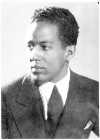 Hughes was an American poet and a central figure of the Harlem Renaissance. His writing is largely concerned with depicting African-American life, particularly the experience of the urban African American, and often uses dialect and jazz rhythms. Along with several collections of poetry, Hughes published numerous other works, including several plays, books for children, and novels. While working as a busboy, Hughes launched his literary career by presenting his poems to what poet as he dined? Discuss
Hughes was an American poet and a central figure of the Harlem Renaissance. His writing is largely concerned with depicting African-American life, particularly the experience of the urban African American, and often uses dialect and jazz rhythms. Along with several collections of poetry, Hughes published numerous other works, including several plays, books for children, and novels. While working as a busboy, Hughes launched his literary career by presenting his poems to what poet as he dined? Discuss
Source: The Free Dictionary
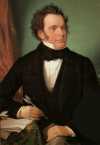 One of the most gifted musicians of the 19th century, Schubert was an Austrian composer who wrote his first of nine symphonies in 1813 at the age of 16. He wrote more than 600 songs, many to the lyrics of German poets, and also composed music for the stage, overtures, choral music, masses, and piano music. He died at 31, having produced more masterpieces by that age than almost any other composer in history. Schubert was buried beside what other famous composer?
One of the most gifted musicians of the 19th century, Schubert was an Austrian composer who wrote his first of nine symphonies in 1813 at the age of 16. He wrote more than 600 songs, many to the lyrics of German poets, and also composed music for the stage, overtures, choral music, masses, and piano music. He died at 31, having produced more masterpieces by that age than almost any other composer in history. Schubert was buried beside what other famous composer? _cropped.jpg) Redgrave is a British actress noted for her versatility and elegant presence. The daughter of actor Michael Redgrave, she made her London stage debut in 1958 and won praise as Rosalind in As You Like It. She went on to become a powerful film actress, earning critical acclaim for her performances in films such as Blow-Up and Julia, for which she won an Oscar. She has also earned Emmy, Tony, Cannes, Golden Globe, and Screen Actors Guild awards but declined what honor in 1999?
Redgrave is a British actress noted for her versatility and elegant presence. The daughter of actor Michael Redgrave, she made her London stage debut in 1958 and won praise as Rosalind in As You Like It. She went on to become a powerful film actress, earning critical acclaim for her performances in films such as Blow-Up and Julia, for which she won an Oscar. She has also earned Emmy, Tony, Cannes, Golden Globe, and Screen Actors Guild awards but declined what honor in 1999?  Chekhov was a Russian short-story writer, dramatist, and physician who earned enduring international acclaim for his stories and plays. His early works were broad humorous sketches and tales published under a pseudonym, written to support himself and his family while he studied for his medical degree in Moscow. His first full-length play, Ivanov, was produced while he was practicing as a doctor. Why was a statue of Chekhov in the town of Tomsk modeled on the perspective of a drunkard?
Chekhov was a Russian short-story writer, dramatist, and physician who earned enduring international acclaim for his stories and plays. His early works were broad humorous sketches and tales published under a pseudonym, written to support himself and his family while he studied for his medical degree in Moscow. His first full-length play, Ivanov, was produced while he was practicing as a doctor. Why was a statue of Chekhov in the town of Tomsk modeled on the perspective of a drunkard?  Stroud was a convicted murderer serving time in prison when he came across some injured sparrows in the Leavenworth prison yard. He kept the birds and soon began raising canaries, which he could sell for supplies and to help support his mother. Using equipment furnished by a new warden, Stroud created an aviary and became an expert in avian pathology, writing two books on the subject and developing a cure for hemorrhagic septicemia. How much of his sentence was spent in solitary confinement?
Stroud was a convicted murderer serving time in prison when he came across some injured sparrows in the Leavenworth prison yard. He kept the birds and soon began raising canaries, which he could sell for supplies and to help support his mother. Using equipment furnished by a new warden, Stroud created an aviary and became an expert in avian pathology, writing two books on the subject and developing a cure for hemorrhagic septicemia. How much of his sentence was spent in solitary confinement?  Carroll was the pen name of Charles Lutwidge Dodgson, English author of Alice’s Adventures in Wonderland and its sequel, Through the Looking Glass, and What Alice Found There. Carroll developed the stories from tales he told to the children of H. G. Liddell, the dean of Christ Church College at Oxford, one of whom was named Alice. Many of his characters—the Mad Hatter, the March Hare, and the White Rabbit—have become familiar figures in literature. What else did Carroll write?
Carroll was the pen name of Charles Lutwidge Dodgson, English author of Alice’s Adventures in Wonderland and its sequel, Through the Looking Glass, and What Alice Found There. Carroll developed the stories from tales he told to the children of H. G. Liddell, the dean of Christ Church College at Oxford, one of whom was named Alice. Many of his characters—the Mad Hatter, the March Hare, and the White Rabbit—have become familiar figures in literature. What else did Carroll write? 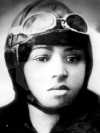 Coleman was an American civil aviator who became the first female pilot of African-American descent and the first person of African-American descent to hold an international pilot license. After attaining her license in France, Coleman continued to train extensively and earned a living as a stunt pilot in air shows, earning the nickname “Queen Bess.” She died in an aviation accident in 1926, but her legacy inspired countless aviators. What led to the accident that resulted in Coleman’s death?
Coleman was an American civil aviator who became the first female pilot of African-American descent and the first person of African-American descent to hold an international pilot license. After attaining her license in France, Coleman continued to train extensively and earned a living as a stunt pilot in air shows, earning the nickname “Queen Bess.” She died in an aviation accident in 1926, but her legacy inspired countless aviators. What led to the accident that resulted in Coleman’s death? 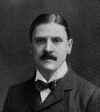 Maugham was an English novelist, playwright, and short-story writer who abandoned a career in medicine when his first novel had some success. He wrote several popular plays and a total of eight novels before writing his breakthrough masterpiece, the partly autobiographical Of Human Bondage (1915). An expert storyteller, Maugham based many of his stories on his own experiences, including what short story collection that influenced Ian Fleming’s James Bond series?
Maugham was an English novelist, playwright, and short-story writer who abandoned a career in medicine when his first novel had some success. He wrote several popular plays and a total of eight novels before writing his breakthrough masterpiece, the partly autobiographical Of Human Bondage (1915). An expert storyteller, Maugham based many of his stories on his own experiences, including what short story collection that influenced Ian Fleming’s James Bond series? 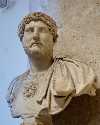 The nephew of Roman emperor Trajan, Hadrian became emperor when he was adopted and named successor just before Trajan’s death, after years of intrigue. After executing his senatorial opponents and abandoning many of Trajan’s conquests, he began to travel widely, and many of his accomplishments were related to his visits abroad, including the beginning of construction of Hadrian’s Wall. The wall is one of the largest and most significant remains of the Roman occupation of what area?
The nephew of Roman emperor Trajan, Hadrian became emperor when he was adopted and named successor just before Trajan’s death, after years of intrigue. After executing his senatorial opponents and abandoning many of Trajan’s conquests, he began to travel widely, and many of his accomplishments were related to his visits abroad, including the beginning of construction of Hadrian’s Wall. The wall is one of the largest and most significant remains of the Roman occupation of what area?  One of the foremost French artists of the 19th century, Manet is often regarded as the father of modern painting. Rebelling against the academic tradition, he developed a realist style that was one of the founding forces of Impressionism. Although his talent is recognized today, Manet was often greeted with harsh criticism during his career, including for his paintings Le déjeuner sur l’herbe—The Luncheon on the Grass—and Olympia. Why were the paintings controversial?
One of the foremost French artists of the 19th century, Manet is often regarded as the father of modern painting. Rebelling against the academic tradition, he developed a realist style that was one of the founding forces of Impressionism. Although his talent is recognized today, Manet was often greeted with harsh criticism during his career, including for his paintings Le déjeuner sur l’herbe—The Luncheon on the Grass—and Olympia. Why were the paintings controversial?